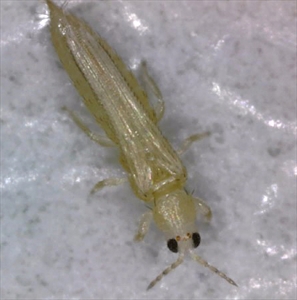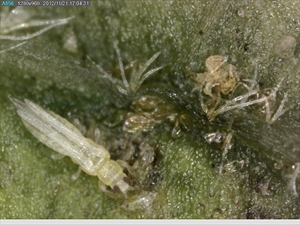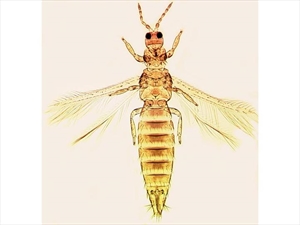Onion thrips
Pacific Pests, Pathogens, Weeds & Pesticides - Online edition
Pacific Pests, Pathogens, Weeds & Pesticides
Onion thrips (117)
Thrips tabaci
Asia, Africa, North, South and Central America, the Caribbean, Europe, Oceania. It is recorded from Australia, American Samoa, Federates States of Micronesia, Fiji, New Caledonia, New Zealand, Northern Mariana Islands, Palau, Papua New Guinea, Solomon Islands, Tonga, and Vanuatu.
Onions are a preferred host, but infestations also occur on onion relatives, beans, brassicas, carrot, cotton, cucurbits, legumes, papaya, pineapple, potato, tobacco, tomato and many ornamentals. At least 25 plant families are infested.
Thrips mouthparts are beak-shaped; the left mandible is much larger than the right, and forms a narrow stylet used to pierce the cell wall of plant tissues. They suck out the contents of cells, leaving air-filled spaces beneath the surface, giving the plants a silvery (and in some case a silvery-bronze) look in sunlight (e.g., on capsicum, cucumber and leek). It is a common symptom on leeks, onion and shallots (Photo 1). The feeding produces distorted leaves (e.g., bronze blisters on cabbage), discolouration (e.g., capsicum flowers), withering from water loss (e.g., onion) and death (especially seedlings of onion and cabbages).
Thrips are parthenogenetic, that means females do not need males in order to produce fertile eggs. Eggs are white, kidney-shaped, about 0.25 mm long and 0.12 mm wide. Males occur, but they are rare. The eggs are placed singly in slits in leaves and flowers. They hatch in 2-4 days, and the larvae - they look like small adults without wings - are yellow, and group together in leaf axils.
The larvae moult once, and then when fully formed drop to the soil and develop into pupae. The adults emerge a few days later; they are yellow and brown with red eyes (Photos 2-4), and about 1.5 mm long. The entire life cycle, from egg to adult is about 11 days at 30°C.
Thrips are not strong fliers, but they move short distances (a few metres) from dying weeds to crop plants, and over long distances (tens or hundreds of kilometres) when large numbers are caught in warm updrafts. Spread also occurs with the international trade of pot plants and cut flowers.
The adults and young (larvae) do the damage. Reduction of yields is common and death of entire crops can occur. In the USA, 50 adult thrips per onion results in a 50 per cent loss of yield.
Tiny black faecal specks occur on leaves and flower parts and make plants unattractive to consumers, and this adds to the economic loss to growers.
Indirect damage occurs as the thrips spread Tomato spotted wilt virus, a serious disease of many vegetables, especially tomato, capsicum and lettuce (but not onions). Weeds serve as an important reservoir for the virus. Symptoms are purple-brown blotches on stems, ring patterns and blotches with haloes on leaves, and discoloured flowers. Young stages of the thrips acquire the virus within 15 minutes of feeding on infected plants and, a few days later, when adult, they transmit the virus, and continue doing so for the remainder of their lives.
Look for thrips on the leaves or in the buds and flowers. This is usually done by shaking, tapping or washing the plants.
NATURAL ENEMIES
Many natural enemies of Thrips tabaci have been reported, but few, if any, are specific to the pest. Predators include bugs, beetles, lacewings, flies, mites and predatory thrips, and there are wasps and fungal parasites. Some predators consume large number of thrips each day, but many also feed on other insects, and give them higher priority. IPM programs for greenhouses use yellow sticky cards for scouting, sanitation, commercial preparations of the fungus Verticilium lecanii, predatory mites, lacewings, and strategic use of insecticides.
|CULTURAL CONTROL
Before planting:
-
Do not plant the same crop successively on the same land; leave a break of 2-3 years.
-
Plant new crops upwind from older crops where thrips occurred.
-
Inspect seedlings transplanted from the nursery and remove those infested.
During growth:
-
Apply mulch to suppress weeds, to reduce soil moisture loss, and increase organic matter.
-
Remove plants with signs of Tomato spotted wilt virus as soon as they are seen.
-
If crops are grown in enclosures, early detection of thrips is important. Use yellow sticky cards placed just above the crop to monitor the presence of thrips. If yellow sticky cards are not available, check flowers for thrips by tapping them over paper.
After harvest:
-
Remove plant debris after harvest or incorporate it into the soil so that it decomposes quickly. Remove any 'volunteer' onions that develop.
RESISTANT VARIETIES
White onion varieties are more tolerant of thrips than red. There are varieties of tomato and capsicum that have resistance to Tomato spotted wilt virus.
CHEMICAL CONTROL
Use insecticides as follows, but note that frequent use of broad spectrum synthetic insecticides may also lead to development of insecticide resistance in thrips populations.
- Use horticultural oil (made from petroleum), white oil (made from vegetable oils), or soap solution (see Fact Sheet no. 56). The spray will not kill all of the thrips, but it will suppress the population enough to allow predator and parasite numbers to build up and start to control them.
- Several soap or oil sprays will be needed to bring the thrips under control. It is essential that the underside of leaves and terminal buds are sprayed thoroughly since these are the areas where the thrips congregate. It is best to spray between 4 and 6 pm to minimise the chance of leaves becoming sunburnt.
- White oil:
- 3 tablespoons (1/3 cup) cooking oil in 4 litres water
- ½ teaspoon pure hand soap, not detergent
- Shake well and use.
- Soap:
-
Use soap (pure soap, not detergent).
- 5 tablespoons of soap in 4 litres water.
-
- White oil:
- Commercial horticultural oil can also be used.
- Use neem to discourage adults from feeding and laying their eggs on the plants (see Fact Sheet no. 56).
- Do not use broad-spectrum insecticides such as dimethoate (under review in Australia, and not allowed for use in home gardens), malathion or a synthetic pyrethroid. They have a greater effect on the natural enemies of onion thrips than on the thrips.
____________________
When using a pesticide, (even a biopesticide) always wear protective clothing and follow the instructions on the product label, such as dosage, timing of application, and pre-harvest interval. Recommendations will vary with the crop and system of cultivation. Expert advice on the most appropriate pesticide to use should always be sought from local agricultural authorities.
AUTHOR Grahame Jackson
Information from CABI (2014) Thrips tabaci (onion thrips). Crop Protection Compendium (https://www.cabi.org/cpc/datasheet/53746); and Onion thrips (2013) Cooperative Extension. University of Minnesota. (http://cues.cfans.umn.edu/old/inter/inmine/Thripk.html); and Thrips tabaci. Wikipedia. (https://en.wikipedia.org/wiki/Thrips_tabaci); and from Waterhouse DF, Norris KR (1989) Thrips tabaci Linderman. Biological Control Pacific Prospects - Supplement 1. Photos 1&2 Rehan Silva University of Queensland.
Produced with support from the Australian Centre for International Agricultural Research under project PC/2010/090: Strengthening integrated crop management research in the Pacific Islands in support of sustainable intensification of high-value crop production, implemented by the University of Queensland and the Secretariat of the Pacific Community.







